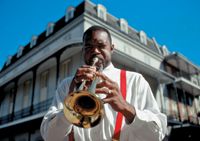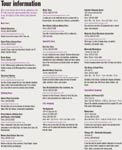Article
City Guide: The heart and soul of New Orleans
The French Quarter, the original site of New Orleans, is best known for its (wild and crazy) nightlife, hotel balconies, glamorous restaurants, jazz-inspired musicians, and bars unlike any other.

Keypoints:

The French Quarter was founded by the French in 1718. King Louis XV mandated Catholic Ursuline nuns to travel to the new territory. The nuns arrived in 1727 and built the Old Ursuline Convent in 1734. France controlled the site until 1763, when Spain assumed control. The Spanish influence was left behind on much of the architecture in the Quarter, especially the cast iron on the balconies, brick and stucco exterior walls, and tiles on roofs.
The French Quarter boasts a breathtaking collection of living architecture and history. Visitors often start the journey through the Quarter at Jackson Square, a cast-iron-fenced area of grass and flowering trees between St. Ann and St. Peter streets across Decatur Street from the river. Originally known as the Place d'Armes, the square served as a military parade ground and the staging point for public executions. Today, Jackson Square is a popular gathering spot to absorb some of the most well-preserved 19th-century architecture in the United States.

Downriver from Jackson Square on Decatur Street is the historic French Market, which opened in 1791 as a farmer's market. Today, visitors can choose from fresh produce, seafood, and varied Louisiana delicacies around the clock. Although one may revel in the grandeur of the French Market and Jackson Square's architectural design, the real enchantment occurs on Rue Royale – Royal Street, the Quarter's fashionable boulevard. Visitors can walk alongside a nearly unbroken string of well-preserved Creole buildings dating back to the early 1800s.

Exploring the upper end, which is actually downriver, you'll run across Architect's Row at 1105-1141 Royal, a series of once-identical row houses built in 1832 and altered individually over time. And at the Quarter's edge on the corner of Esplanade and Royal is the Gauche Villa, an ornate Italianate mansion built in 1856.
Other architectural gems include the 1727 Ursuline Convent at 1112 Chartres, possibly the oldest building in the Mississippi Valley, and the 175-year-old Beauregard-Keyes House at 1113 Chartres, which formerly was the home of General P.G.T. Beauregard and author Frances Parkinson Keyes. Yet another contender would be the Hermann-Grima House at 820 St. Louis St., an 1831 Federal-style mansion now open as a museum depicting Creole life in the mid-1800s.




